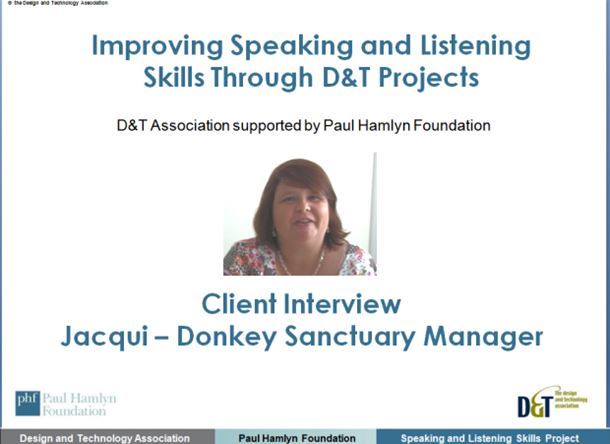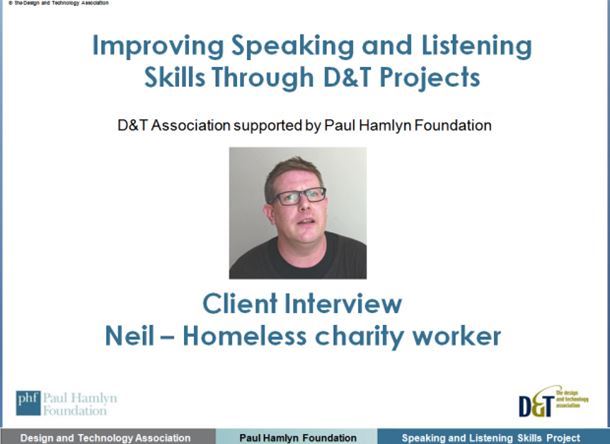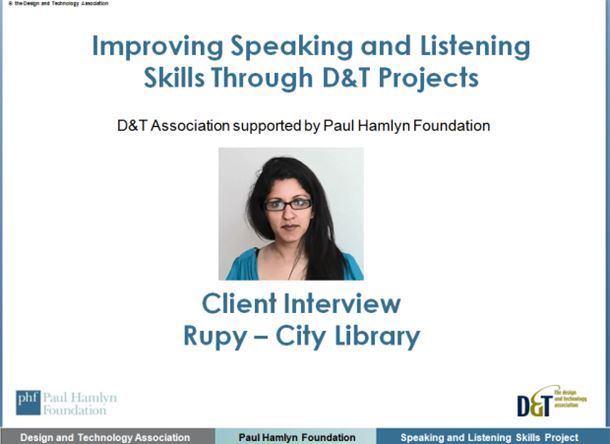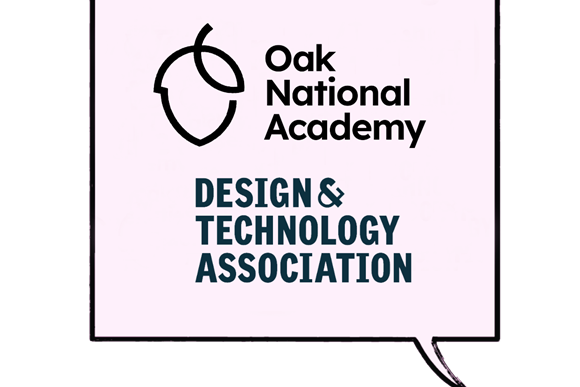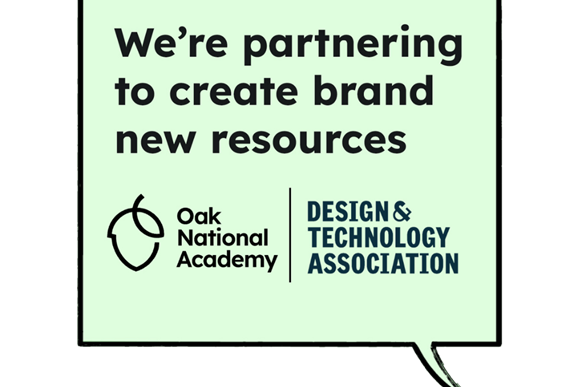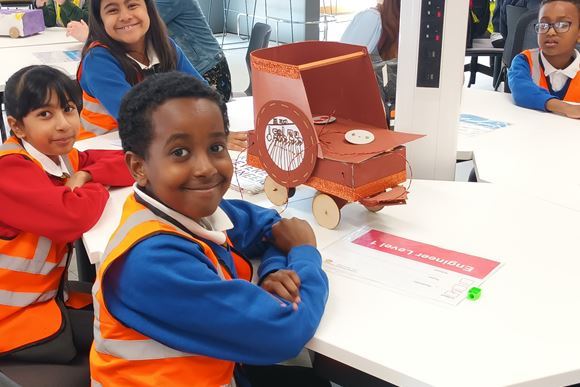Improving speaking and listening skills through D&T projects
This programme, supported by the Paul Hamlyn Foundation, aims to improve the speaking and listening skills of Key Stage 3 students through delivery of a D&T project. Twelve schools were selected to take part in a pilot project and resources have now been developed to allow delivery of the project in schools. The resources have been developed in response to the feedback and challenges encountered by schools, concentrating on bringing out positive aspects of the programme including working with clients in ‘real world’ environments and developing confidence amongst students.
The programme centres on a one-off project with a ‘real world’ community focus, addressing a need in the locality. The programme helps develop students’ speaking and listening skills in areas such as negotiation, questioning clients and preparing for and delivering a presentation as well as providing a D&T solution to an identified need.
Research indicates that schools’ level of staff training in speaking and listening is good where provided, but that not all offer this. Generally, while there are good opportunities in schools for students to present to groups, teachers’ perceptions of students’ levels of confidence and skill in speaking and listening and in preparation for presentations is low.
Resources include virtual client interviews, lesson plans, a scheme of work, assessment materials, video and student support.
Pilot Programme 2013-2014
The participating schools developed ideas with a range of community organisations, and include projects with the following themes:
- Designing a new food product for the school canteen, based on Fairtrade ingredients
- Designing and making a commemorative item for the Tour de France when it visits the area
- Working with a local park to encourage greater interactivity from visitors
- Designing collection boxes for a local charity
- Working with a local architect to outdoor seating for a special school
- Promoting scouting groups to the local community
- Designing and making a textiles-based souvenir product in association with a museum
- Developing designs for a children’s playground
D&T departments worked with colleagues from English departments in delivering the programme and assessments are taking place at different stages to assess students’ progress.
Feedback from the schools that took part has been very positive, with opportunities to work with other departments in school and with groups in the community. The D&T outcomes ranged from designing and making souvenir products for the Tour de France, designs for a homeless charity and the Fairtrade Foundation and working with local churches and parks to produce community-based solutions. Students’ speaking and listening skills improved considerably over the course of the project.
The project has gone really well in school... Progress by pupils in terms of D&T and speaking and listening was great.
The pilot found a number of issues that have since been addressed when developing the resources. Some difficulties were found getting external clients to participate, and while schools found solutions to this by asking other staff and contacts to pose as clients, this was a sticking point for some. In response we have developed three ‘virtual clients’: interviews using video clips as answers to questions posed during the development of designs.
Feedback also clearly indicated the advantages of working alongside English departments in delivering the project and gaining good results for students. We have recorded a discussion between a D&T teacher and Head of Literacy in one school highlighting the importance of this and how effectively they can work together.
I thoroughly enjoyed seeing pupils speaking and listening confidently in a subject outside English. I thought the ‘real life’ aspect of the project was great as well as the competitive element.
The new National Curriculum was being developed over the course of the pilot programme and the resources used have been updated to the new standards, although materials that group members found beneficial have been retained where appropriate.
Free resources
The resources developed include:
Project overview
Contains the project guidance booklet outlining the importance of developing speaking and listening skills, assessment and self assessment, the skills required by the project in conducting research and delivering presentations. Also included are a pdf poster and project flow chart.
1 Introduction
A PowerPoint presentation giving an outline of the project’s aims and objectives and some preliminary findings of schools’ levels of training in speaking and listening and students’ levels of confidence and skill.
2 Speaking and Listening in the project
A PowerPoint presentation with supporting notes detailing the speaking and listening content of the new National Curriculum and how the project can be used to assess and improve skills amongst students. Includes suggestions for roles in discussion, sentence starters, questioning skills, presentation skills and delivery and responding to questions.
3 Project structure and delivery
This outlines the characteristics of the project and how delivery might be structured in school, including analysis of the design brief, preparing for clients, interviewing, ideas generation and selecting the best solution, and presenting final ideas to a client. Also included are a teacher presentation, lesson plans, worksheets and feedback sheets.
Assessment materials
Guidance on levels for speaking and listening, reading and writing, and self assessment forms for students to help determine their confidence and abilities in discussions, interviewing and research, and presenting to an audience.
Guidance from the National Curriculum 2010 National Strategies
A range of materials including video examples of students speaking and listening teachers will find helpful in assessing their students’ levels and progression. Including:
- Guidance – assessment, English as a Second Language, standardisation and moderation
- Training Materials – Speaking and Listening CPD, sample training videos. There are six training resources in total - use the 'search' feature to locate them
Virtual client interviews
Many schools find difficulty getting people from the community to come into school to interact with students, but research has shown that having a ‘real’ client to design and make for helps students develop successful products and develop effective peaking and listening skills. These three virtual interviews in PowerPoint format contain videoed answers to question that might be put by students in interviews. They contain information that students can use to help them design appropriate solutions to the problems presented in each scenario and help give authority to the project. Students will be able to identify better with the client and associate their designs with a real-life situation.
- Interview with donkey sanctuary manager
- Interview with homeless charity worker
- Interview with librarian
Videoed discussion between a D&T teacher and Head of Literacy
A videoed discussion between a member of D&T staff who has delivered the project, and the Literacy co-ordinator in school on how the English and D&T departments can work closely together to improve students’ results. View the discussion
We welcome your feedback on these resources, particularly if you use them to develop a whole scheme for delivery in your school. Please contact Willy Adam.
Join Now
Design and Technology (D&T) is the inspiring, rigorous and practical subject which prepares all young people to live and work in the designed and made world.
We are focused on giving you the tools, knowledge and information you need to become more effective, more experienced and more efficient. Giving you access to expert opinions. And creating a place where you can air your views, ask your questions and so help make a difference to your life and those of your pupils. We want to hear from you. We want to know how we can help. And we want you to join us.

